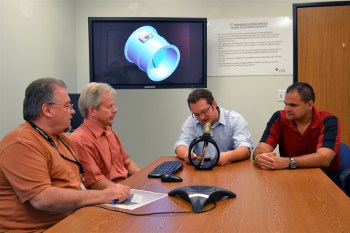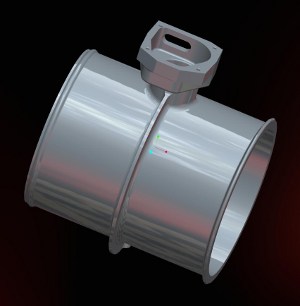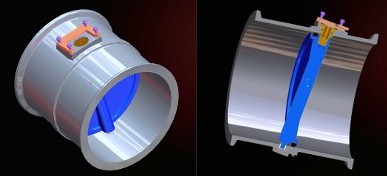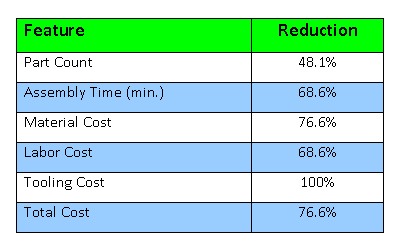 |
| July 17, 2012 | Volume 08 Issue 27 |
Designfax weekly eMagazine
Archives
Partners
Manufacturing Center
Product Spotlight
Modern Applications News
Metalworking Ideas For
Today's Job Shops
Tooling and Production
Strategies for large
metalworking plants
Engineer's Toolbox:
A down-to-earth flight plan for manufacturing success
ITT Aerospace uses DFMA to simplify component designs and improve manufacturability.

A DFMA analysis identified substantial cost-cutting measures and manufacturability improvements for an air-duct valve redesigned by ITT Aerospace Controls' engineering team: (left to right) Dave Vranson, manufacturing engineer; David Clarke, CAD designer; Davey Lopez, lead project engineer; and Peter Ciulla, project engineer.
When ITT Aerospace Controls gets a new design order for one of the company's custom actuators, pumps, switches, or valves, opportunity can come knocking as well. "We're always looking for ways to innovate and improve manufacturability," says David Vranson, advanced manufacturing engineer at the Valencia, CA-based aerospace and military supplier. "An earlier, certified design can be the jump-off point for adaptation and improvement when fulfilling a new order."
In the department where Vranson works, the product development process involves a cross-discipline core team comprised of an engineering project manager, design engineer, designer/draftsmen, one or two manufacturing engineers, and a supply chain rep. Others who come to the initial meeting, and are called on as needed, include representatives from quality, manufacturing, aftermarket services, and even outside suppliers. The process also relies heavily on Design for Manufacture and Assembly (DFMA) software from Boothroyd Dewhurst to steer the analysis.
New design ideas for an old valve
When a manufacturer recently came to ITT Aerospace looking for an air-duct valve, they were interested in small quantities: a retrofit of approximately 100 aircraft at three valves per plane. The valve was part of an air-exchange system that rapidly replaces the cabin air in emergencies, such as when the cabin fills with smoke. The customer provided basic fitting information and system definitions, leaving room for engineering creativity.

A 30-year-old air-duct butterfly-valve assembly used outdated manufacturing technologies and materials. The 7-in.-diameter component was fabricated from rectangular aluminum stock to tight tolerances and included tricky interior surface finishes, all contributing to a difficult assembly process.
"We had a 30-year-old air-duct valve design on our books that matched their requirements. But the materials were outdated, it had some hardships in the manufacturing process, and it would have been extremely expensive to make today," says Vranson.
The original 7-in. air duct valve had a high price tag because the valve bodies were machined from rectangular aluminum billet stock requiring multiple machine setups, critical interior surface finishes, and tight tolerances. What's more, assembling the butterfly disc inside the valve body required Houdini-like contortions involving O-rings, delicate pushing and pulling, and frequent frustration on the factory floor, with occasional repeat assembly procedures hurting yield. "Such a complex product design presented our team with the perfect opportunity for an update with DFMA," says Vranson.
DFMA is an integrated two-part analysis approach for simplifying complex designs and optimizing their costs. The DFA Product Simplification module provides a quantifiable method of benchmarking products and eliminating unnecessary parts and operations. The DFM Concurrent Costing module offers a systematic approach for calculating and examining manufacturing costs and choosing alternative process technologies and material cost-cutting measures. Together, these software tools can help guide the design development process from its inception before manufacturing and life-cycle costs get locked in towards functionally efficient, easy to manufacture and assemble products and components.
Start with product simplification, not cost
"We always begin our DFMA analyses by looking at simplicity first, rather than focusing on cost alone," says Vranson. "If you make cost your priority, you might overlook creative solutions that, in the end, will be less expensive."
Engineers may be misled by the lure of small, uncomplicated parts, which are less expensive per piece. But building an assembly even a straightforward one such as this air-duct valve often requires a lot of different parts. And as part count goes up, fabrication becomes more difficult and costs climb.
Using DFMA, the team is queried by the software to consolidate and/or eliminate parts. Following this strategy, multiple parts are rolled into a single unit, fasteners disappear, and snap and slip joints are substituted for their more-difficult-to-assemble cousins. By itself, the resulting multi-functional part can be more complex geometrically. But when the total part count of the assembly is tallied, it will have decreased significantly. And the effects of lower part count carry forward to dramatic improvements in manufacturability: little or no tooling, easier assembly, and enhanced throughput on the shop floor. "When you aim at simplicity, lower cost just naturally follows," says Vranson.
A butterfly valve's metamorphosis using DFMA
Starting with the original valve design, the ITT Aerospace engineering team ran a Design for Assembly (DFA) analysis to uncover cost hardships. The software's "Suggestions for Redesign" report identified targets for improvement, including specific details based on the actual bill of materials and real-world processing requirements. Several design-change scenarios were loaded into the DFMA software, and with each analysis the engineering team uncovered additional improvements to manufacturability attributes.
"We always run multiple DFMA analyses," says Vranson. "In every round, we build the innovation off results that the software is identifying. And then we take our query even further, going outside the box and asking, What if we did this?'" Those blue-sky questions could be pointing to a radical change in material or shape, or the further consolidation of five or six parts into one.

The new air-duct butterfly-valve assembly is manufactured from round aluminum stock with a near-net diameter and incorporates a seal design with wider tolerances, less-critical surface finishes, and an angled seating arrangement. These features allow for an easier insertion process than was used in the original valve.
With the butterfly valve, this iterative process led to several key improvements: the valve body was now to be machined in a single, mill-turn setup, from round aluminum stock with a near-net diameter; and the seal incorporated wider tolerances, less-critical surface finishes, and an angled seating arrangement in the body with a clever single-axis insertion.
DFMA benefits take off
While DFMA is grounded in design and business basics such as material selection, process costs, parts simplification, tooling efficiencies, and assembly strategies the results are anything but down to earth.
On the butterfly valve project, design changes led to dramatic reductions in part count (48%), assembly time (69%), and total cost (77%), including labor, materials, and tooling. Other benefits included the near-elimination of rework during assembly, decreased opportunity for defects, improved inventory management, and higher performance of the valve: all outcomes that get high customer-satisfaction marks.

In addition, the engineering team came up with a sealing technology innovation that will cross-pollinate every butterfly valve in the company's portfolio. "Anything that we can do to improve our products, even at low volumes, is worth it," says Vranson. "We're going to take that discovery and apply it to our entire product line to improve product performance and future business."
DFMA and Lean are on the same team
These kinds of successes in product redesign underscore an important point Vranson likes to make about how DFMA and Lean can work together to optimize manufacturability. "If you release designs that are intrinsically inefficient to manufacture, the source of the problem becomes invisible once the product hits the factory floor," he says. In other words, if designs have manufacturability issues built in, "Leaning out" the production line will not get rid of the assembly delays or unforeseen costs that result from poor design. The problem lies not in production, but in the design itself.
Vranson's recommendation is to use DFMA in the design cycle pre-release before the component is turned over to manufacturing making the product Lean from the start.
He then suggests using Lean post-release after the design is finalized to trim any remaining inefficiencies from the production process. He sees the two techniques as complementary, each contributing its own specialized, waste-cutting techniques.
Eliminating waste in the design phase is especially important for ITT Aerospace due to the rigorous testing and qualification hurdles inherent to the aerospace industry. Since FAA approvals are involved, and redesign is either almost impossible or prohibitively expensive, getting it right the first time is critical.
Although ITT Aerospace has only been using DFMA for a few years, the observed benefits from finance to supply chain, parts handling, and quality are already stimulating queries from interested engineers and managers in the company's other business units and divisions.
Vranson would like to see the improvements that he knows are possible ripple throughout the entire organization. "I want to show our other units how DFMA works and help them set up similar design-for-manufacturability programs," says Vranson. "The software is not a replacement for innovation, but it really sparks it."
Want more information? Click below.
Boothroyd Dewhurst
Source: Boothroyd Dewhurst
Published July 2012
Rate this article
View our terms of use and privacy policy
